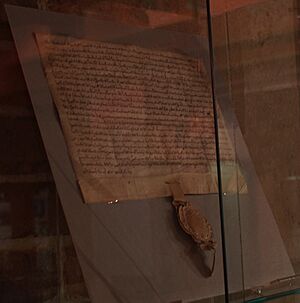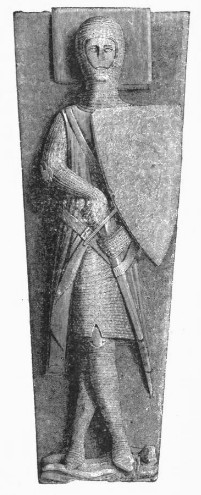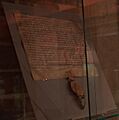William Longespée the Younger facts for kids

Sir William Longespée (born around 1212 – died February 8, 1250) was a brave English knight and crusader. He was the son of William Longespée and Ela, Countess of Salisbury. William Longespée became famous because he died fighting heroically in the Battle of Mansurah in Egypt. His death was very important to the English people.
Contents
Who Was William Longespée?
Early Life and Family
William Longespée was born into an important family. His father was also named William Longespée, and his mother was Ela, Countess of Salisbury. Being a knight in those times meant being a soldier who often fought for their king and their faith.
First Journey to the Holy Land
William Longespée went on two important journeys to the Holy Land, which were called crusades. His first journey was part of the Barons' Crusade. On June 10, 1240, he left England with Richard, 1st Earl of Cornwall and many other knights.
They traveled to Marseilles and then sailed to Acre, arriving on October 8. During this trip, William and his group did not fight any battles. Instead, they helped finish peace talks with Ayyubid leaders. They also helped rebuild Ascalon castle. On April 13, 1241, they exchanged Muslim prisoners for Christian captives. William Longespée likely returned to England with Richard on May 3, 1241.
Fighting in the Seventh Crusade
William Longespée went on his second journey to the Holy Land in 1247. This was part of the Seventh Crusade. He first went to Rome to ask Pope Innocent IV for help. He explained that he was going on the crusade with King Louis of France, but he needed money.
He told the Pope that even though his family name was famous, he didn't have much wealth. He asked for the Pope's support to help him fund his journey. The Pope agreed to help him.
Raising Money for the Crusade
To get money for his trip, William Longespée sold special documents called "charters of liberties" to towns. In 1248, he sold a charter to the people of Poole for 70 marks. This charter gave the townspeople more freedom and rights. He also sold a charter to the town of Wareham.
Leading English Knights
During the Seventh Crusade, William Longespée was in charge of the English soldiers. He became very well known for his bravery and knightly skills. He was seen as a hero who died for his beliefs.
The Battle of Mansurah
William Longespée died heroically at the Battle of Mansurah. It is said that the French Count d'Artois rushed into battle against the Mameluks (Egyptian soldiers) before King Louis's main army arrived. William Longespée and his English knights, along with many Knights Templar, followed the Count d'Artois into the fight.
Sadly, Count d'Artois, William Longespée, and many of their men were killed in this battle. This event made the English people even more upset with the French.
A Mother's Vision
It is told that William's mother, Countess Ela, had a special vision on the day he died. She saw her son being welcomed into heaven by angels.
In 1252, William Longespée's remains were sent back to Acre and buried in the church of St Cross. However, a statue of him can be found among his family members at Salisbury Cathedral in England.
Stories of His Final Fight
Matthew Paris, a writer from that time, described William Longespée's death. He wrote that Count d'Artois told William to escape when the battle was going badly. But William bravely replied, "Please God, the son of my father shall never fly from any Saracen! I would rather die a good death than live a base life."
Count d'Artois then fled and drowned. William Longespée, seeing that he would die, fought with incredible courage. Even after his horse fell and his own feet were injured, he kept fighting. He was hit many times and eventually died, becoming a "most glorious martyr." His standard bearer, Robert de Vere, and many other English knights died with him.
There is also a poem that tells another story of his death. It describes how William Longespée fought fiercely, breaking through enemy lines. He was severely wounded, losing a foot and a hand, but he continued to fight with his remaining strength. He refused to surrender, saying, "I came hither to serve God and will die for him, but before I die I will send myself dear." Finally, he fell, surrounded by his enemies.
Family Life
William Longespée married Idoine de Camville. They had three sons and one daughter:
- Ela Longespée, who married James Audley.
- William III Longespée, who married Maud de Clifford. William III died before his grandmother, Ela. His daughter, Margaret, later married Henry de Lacy, 3rd Earl of Lincoln.
- Richard Longespée, who married Alice le Rus.
- Edmund Longespée.
Images for kids



